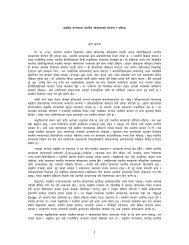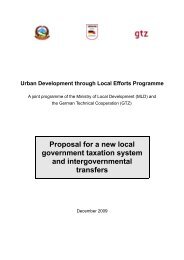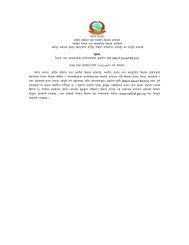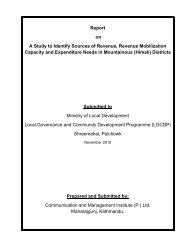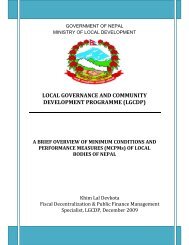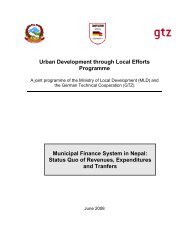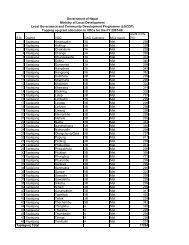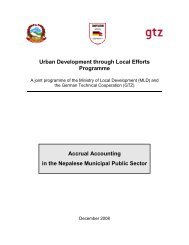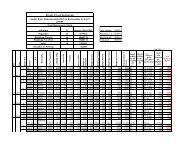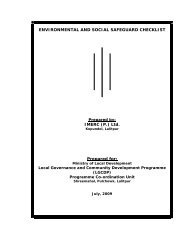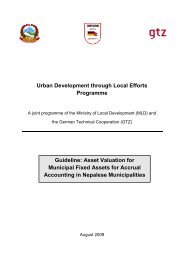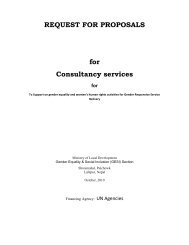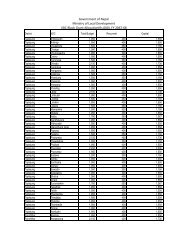LGCDP M&E Framework
LGCDP M&E Framework
LGCDP M&E Framework
Create successful ePaper yourself
Turn your PDF publications into a flip-book with our unique Google optimized e-Paper software.
Access to public goods/drinking water<br />
Indicator: % of rural households with sustainable access to improved water source<br />
Rationale: Drinking water through reservoirs and pipes is a typical service provided by local<br />
governments through <strong>LGCDP</strong>.<br />
Limits:<br />
According to the Nepal Demographic and Health Surveys, “improved source” refers to piped<br />
water into house/yard/plot, public tap/standpipe, tube well or borehole, protected dug,<br />
protected spring and rainwater. Non-improved source include unprotected dug well,<br />
unprotected spring, tanker truck, surface water.<br />
Baseline: 80.2% (2006)<br />
Target:<br />
Target to be determined<br />
Means of<br />
Nepal Demographic and Health Surveys<br />
Verification<br />
Frequency not known<br />
Responsibility Population Division, Ministry of Health and Population<br />
Access to public services<br />
Indicators: • % of citizens that say that the services of DDCs are more accessible than<br />
they were one year ago<br />
• % of citizens that say that the services of VDCs are more accessible than<br />
they were one year ago<br />
• % of citizens that say that the services of municipalities are more<br />
accessible than they were one year ago<br />
Rationale: Apart from access to infrastructure, this indicator captures changes in perceived<br />
accessibility of public services delivered by the DDC, VDCs and municipalities. The indicator<br />
generally captures “access” to services, which includes that the person providing the<br />
service is available, accessible, able and capable of providing it. The indicator tracks<br />
changes in perception over a one-year period rather than a static measure of client<br />
satisfaction.<br />
Limits: • This indicator does not disaggregate the different types of services provided by<br />
the DDCs/VDCs/municipalities, but gives an overall picture of changes in the<br />
perceptions of citizens. The data is obviously subjective and influenced by many<br />
external factors. However, at a highly aggregated level and tracked over<br />
numerous years the data will be able to show trends and tendencies.<br />
• The one-year recall was chosen because changes in perception can be reasonably<br />
expected within a year, and it is not too far for citizens to still be able to<br />
remember the status 12 months ago.<br />
Baseline: To be determined by <strong>LGCDP</strong> baseline survey in 2009<br />
Target:<br />
To be determined after the <strong>LGCDP</strong> baseline survey<br />
Means of<br />
<strong>LGCDP</strong> sample surveys<br />
Verification<br />
Frequency every 2 years (2009, 2011, 2013)<br />
Responsibility M&E Section of MLD<br />
6



